Case Study: Managing and Leading People Through Change at Biogen Idec
VerifiedAdded on 2021/04/21
|13
|3851
|35
Case Study
AI Summary
This case study analysis examines the significant organizational and cultural changes undertaken by Biogen Idec, focusing on the shift of its center of excellence to Zug, Switzerland. The report delves into individual change, team dynamics, and organizational transformation, highlighting the application of Herzberg's and Maslow's theories to employee motivation during the transition. It explores the importance of teamwork in managing change, the steps involved in the change process, and the generation of short-term wins to sustain momentum. The analysis covers the impact of the relocation on employees, the strategies used to overcome barriers, and the importance of sustaining acceleration to ensure long-term success. The case study underscores the complexities of leadership in driving organizational change and the need for effective communication and planning to manage transitions successfully.

[Date]
Managing and leading people
Case Study Analysis – Biogen Idec.
Managing and leading people
Case Study Analysis – Biogen Idec.
Paraphrase This Document
Need a fresh take? Get an instant paraphrase of this document with our AI Paraphraser
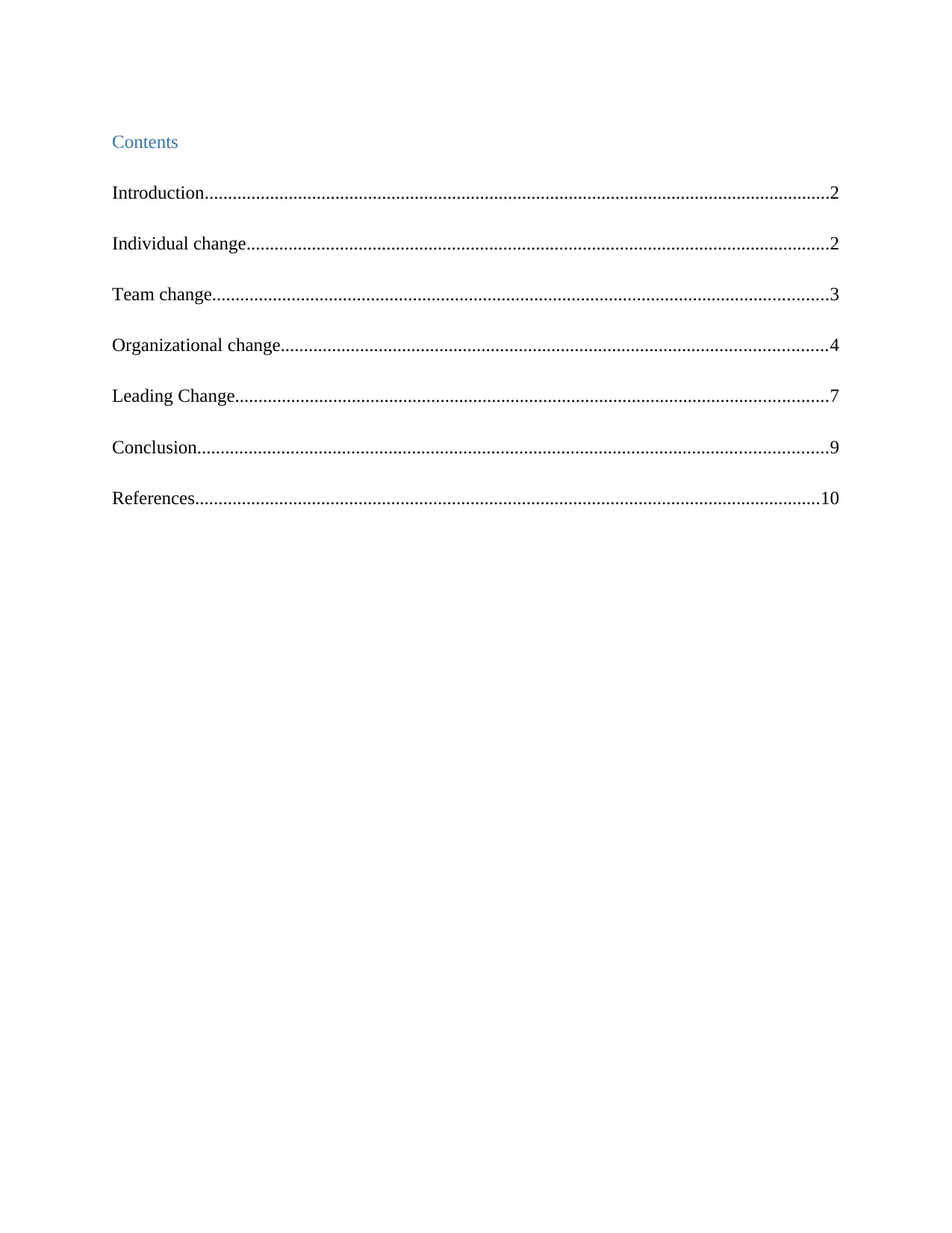
Contents
Introduction......................................................................................................................................2
Individual change.............................................................................................................................2
Team change....................................................................................................................................3
Organizational change.....................................................................................................................4
Leading Change...............................................................................................................................7
Conclusion.......................................................................................................................................9
References......................................................................................................................................10
Introduction......................................................................................................................................2
Individual change.............................................................................................................................2
Team change....................................................................................................................................3
Organizational change.....................................................................................................................4
Leading Change...............................................................................................................................7
Conclusion.......................................................................................................................................9
References......................................................................................................................................10
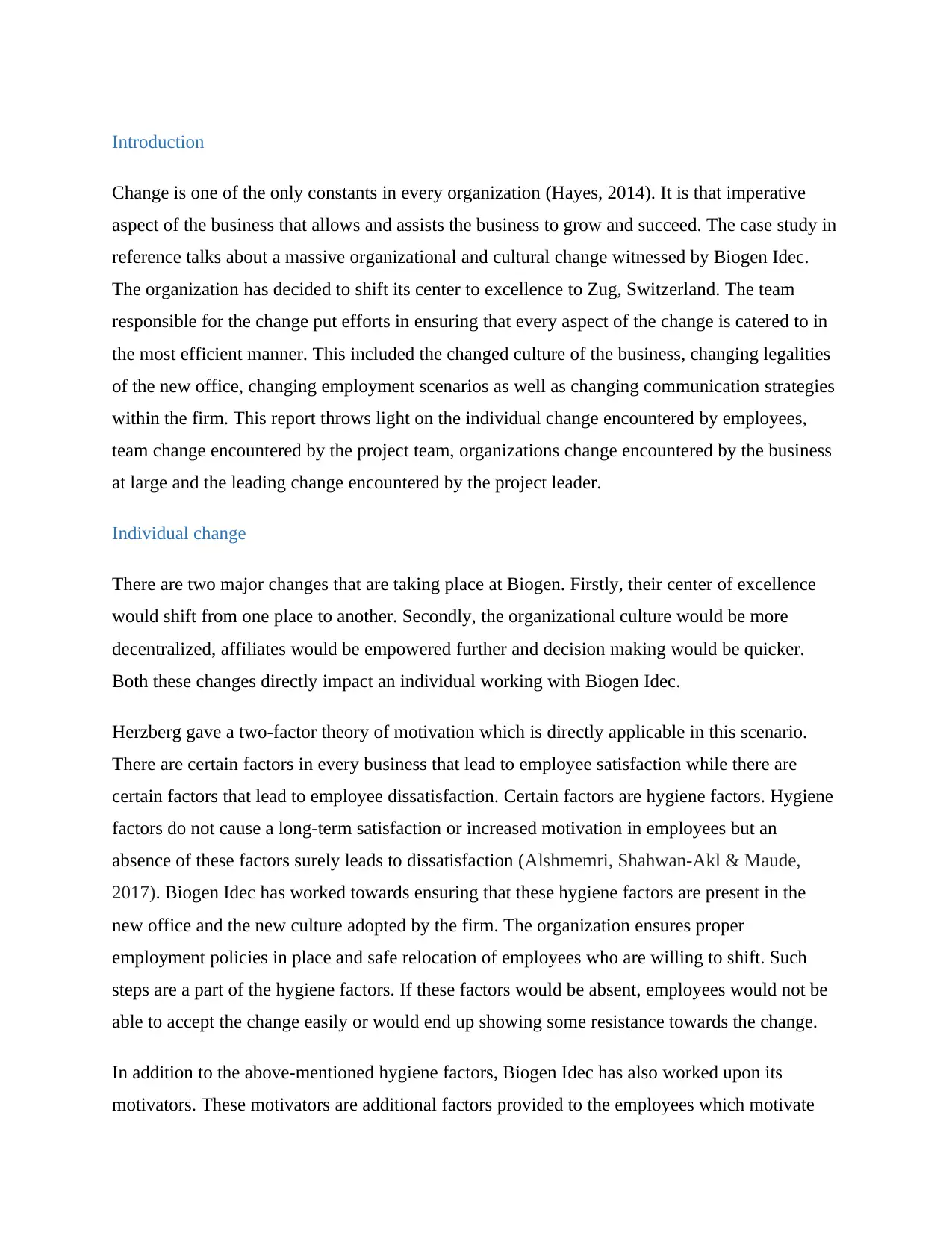
Introduction
Change is one of the only constants in every organization (Hayes, 2014). It is that imperative
aspect of the business that allows and assists the business to grow and succeed. The case study in
reference talks about a massive organizational and cultural change witnessed by Biogen Idec.
The organization has decided to shift its center to excellence to Zug, Switzerland. The team
responsible for the change put efforts in ensuring that every aspect of the change is catered to in
the most efficient manner. This included the changed culture of the business, changing legalities
of the new office, changing employment scenarios as well as changing communication strategies
within the firm. This report throws light on the individual change encountered by employees,
team change encountered by the project team, organizations change encountered by the business
at large and the leading change encountered by the project leader.
Individual change
There are two major changes that are taking place at Biogen. Firstly, their center of excellence
would shift from one place to another. Secondly, the organizational culture would be more
decentralized, affiliates would be empowered further and decision making would be quicker.
Both these changes directly impact an individual working with Biogen Idec.
Herzberg gave a two-factor theory of motivation which is directly applicable in this scenario.
There are certain factors in every business that lead to employee satisfaction while there are
certain factors that lead to employee dissatisfaction. Certain factors are hygiene factors. Hygiene
factors do not cause a long-term satisfaction or increased motivation in employees but an
absence of these factors surely leads to dissatisfaction (Alshmemri, Shahwan-Akl & Maude,
2017). Biogen Idec has worked towards ensuring that these hygiene factors are present in the
new office and the new culture adopted by the firm. The organization ensures proper
employment policies in place and safe relocation of employees who are willing to shift. Such
steps are a part of the hygiene factors. If these factors would be absent, employees would not be
able to accept the change easily or would end up showing some resistance towards the change.
In addition to the above-mentioned hygiene factors, Biogen Idec has also worked upon its
motivators. These motivators are additional factors provided to the employees which motivate
Change is one of the only constants in every organization (Hayes, 2014). It is that imperative
aspect of the business that allows and assists the business to grow and succeed. The case study in
reference talks about a massive organizational and cultural change witnessed by Biogen Idec.
The organization has decided to shift its center to excellence to Zug, Switzerland. The team
responsible for the change put efforts in ensuring that every aspect of the change is catered to in
the most efficient manner. This included the changed culture of the business, changing legalities
of the new office, changing employment scenarios as well as changing communication strategies
within the firm. This report throws light on the individual change encountered by employees,
team change encountered by the project team, organizations change encountered by the business
at large and the leading change encountered by the project leader.
Individual change
There are two major changes that are taking place at Biogen. Firstly, their center of excellence
would shift from one place to another. Secondly, the organizational culture would be more
decentralized, affiliates would be empowered further and decision making would be quicker.
Both these changes directly impact an individual working with Biogen Idec.
Herzberg gave a two-factor theory of motivation which is directly applicable in this scenario.
There are certain factors in every business that lead to employee satisfaction while there are
certain factors that lead to employee dissatisfaction. Certain factors are hygiene factors. Hygiene
factors do not cause a long-term satisfaction or increased motivation in employees but an
absence of these factors surely leads to dissatisfaction (Alshmemri, Shahwan-Akl & Maude,
2017). Biogen Idec has worked towards ensuring that these hygiene factors are present in the
new office and the new culture adopted by the firm. The organization ensures proper
employment policies in place and safe relocation of employees who are willing to shift. Such
steps are a part of the hygiene factors. If these factors would be absent, employees would not be
able to accept the change easily or would end up showing some resistance towards the change.
In addition to the above-mentioned hygiene factors, Biogen Idec has also worked upon its
motivators. These motivators are additional factors provided to the employees which motivate
⊘ This is a preview!⊘
Do you want full access?
Subscribe today to unlock all pages.

Trusted by 1+ million students worldwide
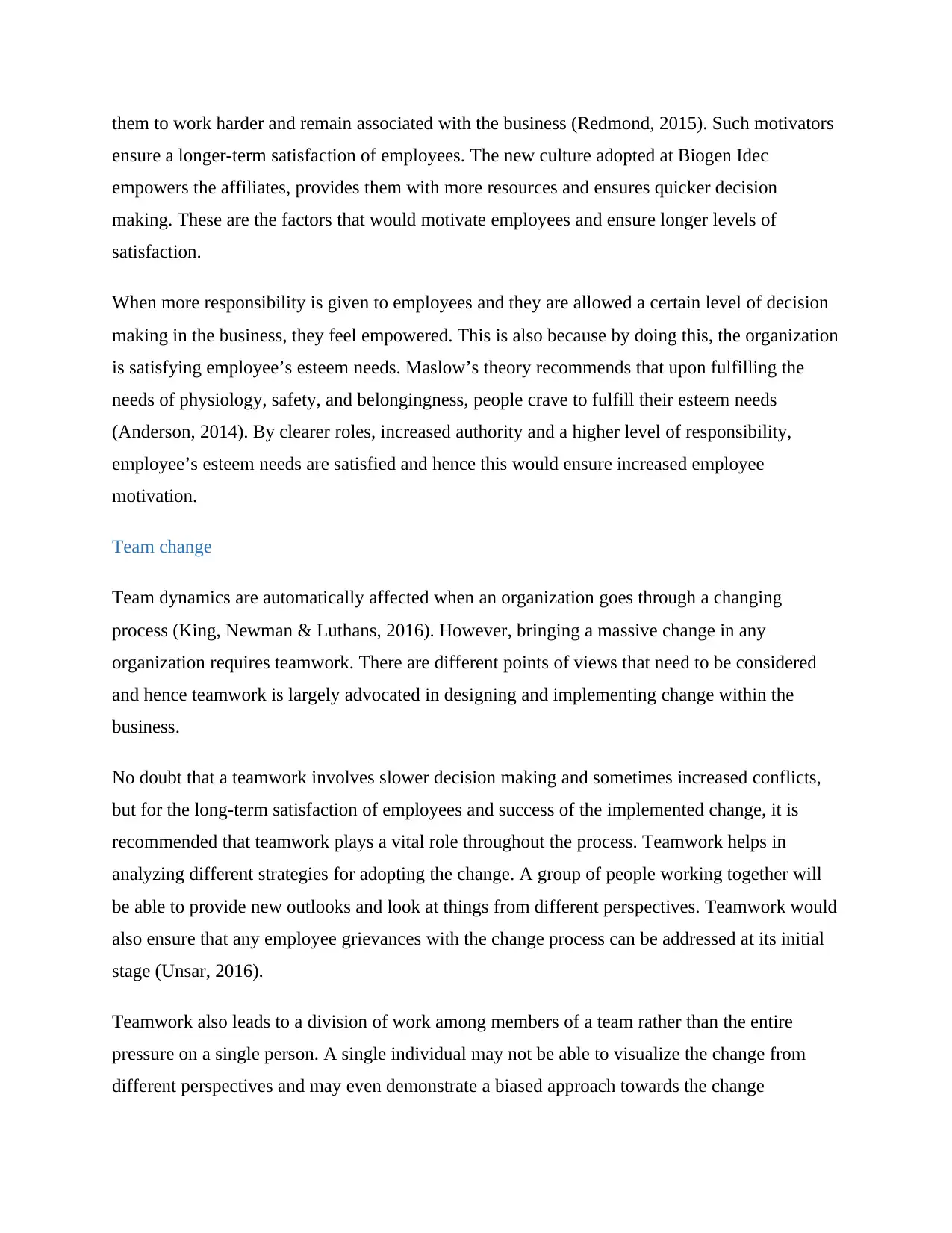
them to work harder and remain associated with the business (Redmond, 2015). Such motivators
ensure a longer-term satisfaction of employees. The new culture adopted at Biogen Idec
empowers the affiliates, provides them with more resources and ensures quicker decision
making. These are the factors that would motivate employees and ensure longer levels of
satisfaction.
When more responsibility is given to employees and they are allowed a certain level of decision
making in the business, they feel empowered. This is also because by doing this, the organization
is satisfying employee’s esteem needs. Maslow’s theory recommends that upon fulfilling the
needs of physiology, safety, and belongingness, people crave to fulfill their esteem needs
(Anderson, 2014). By clearer roles, increased authority and a higher level of responsibility,
employee’s esteem needs are satisfied and hence this would ensure increased employee
motivation.
Team change
Team dynamics are automatically affected when an organization goes through a changing
process (King, Newman & Luthans, 2016). However, bringing a massive change in any
organization requires teamwork. There are different points of views that need to be considered
and hence teamwork is largely advocated in designing and implementing change within the
business.
No doubt that a teamwork involves slower decision making and sometimes increased conflicts,
but for the long-term satisfaction of employees and success of the implemented change, it is
recommended that teamwork plays a vital role throughout the process. Teamwork helps in
analyzing different strategies for adopting the change. A group of people working together will
be able to provide new outlooks and look at things from different perspectives. Teamwork would
also ensure that any employee grievances with the change process can be addressed at its initial
stage (Unsar, 2016).
Teamwork also leads to a division of work among members of a team rather than the entire
pressure on a single person. A single individual may not be able to visualize the change from
different perspectives and may even demonstrate a biased approach towards the change
ensure a longer-term satisfaction of employees. The new culture adopted at Biogen Idec
empowers the affiliates, provides them with more resources and ensures quicker decision
making. These are the factors that would motivate employees and ensure longer levels of
satisfaction.
When more responsibility is given to employees and they are allowed a certain level of decision
making in the business, they feel empowered. This is also because by doing this, the organization
is satisfying employee’s esteem needs. Maslow’s theory recommends that upon fulfilling the
needs of physiology, safety, and belongingness, people crave to fulfill their esteem needs
(Anderson, 2014). By clearer roles, increased authority and a higher level of responsibility,
employee’s esteem needs are satisfied and hence this would ensure increased employee
motivation.
Team change
Team dynamics are automatically affected when an organization goes through a changing
process (King, Newman & Luthans, 2016). However, bringing a massive change in any
organization requires teamwork. There are different points of views that need to be considered
and hence teamwork is largely advocated in designing and implementing change within the
business.
No doubt that a teamwork involves slower decision making and sometimes increased conflicts,
but for the long-term satisfaction of employees and success of the implemented change, it is
recommended that teamwork plays a vital role throughout the process. Teamwork helps in
analyzing different strategies for adopting the change. A group of people working together will
be able to provide new outlooks and look at things from different perspectives. Teamwork would
also ensure that any employee grievances with the change process can be addressed at its initial
stage (Unsar, 2016).
Teamwork also leads to a division of work among members of a team rather than the entire
pressure on a single person. A single individual may not be able to visualize the change from
different perspectives and may even demonstrate a biased approach towards the change
Paraphrase This Document
Need a fresh take? Get an instant paraphrase of this document with our AI Paraphraser
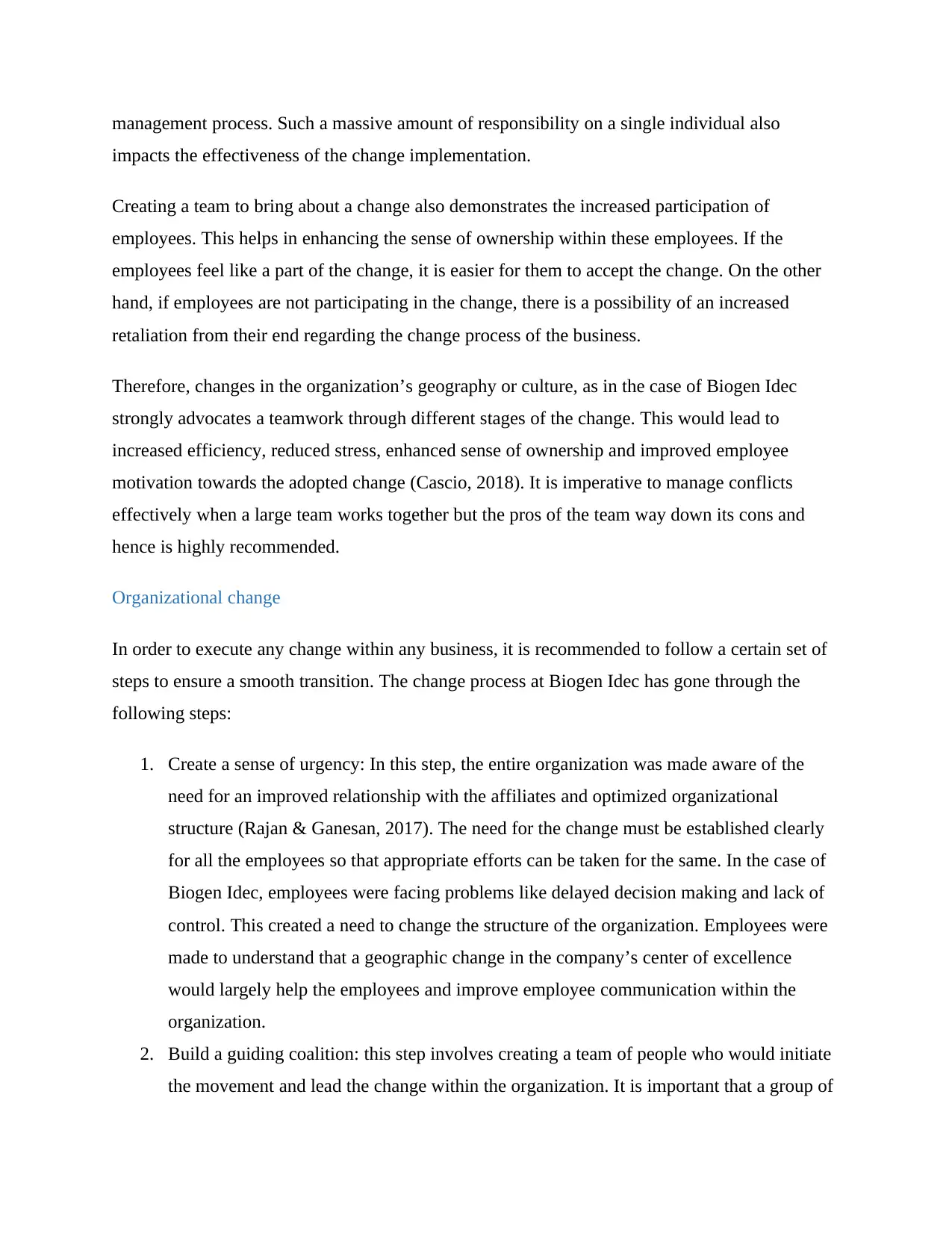
management process. Such a massive amount of responsibility on a single individual also
impacts the effectiveness of the change implementation.
Creating a team to bring about a change also demonstrates the increased participation of
employees. This helps in enhancing the sense of ownership within these employees. If the
employees feel like a part of the change, it is easier for them to accept the change. On the other
hand, if employees are not participating in the change, there is a possibility of an increased
retaliation from their end regarding the change process of the business.
Therefore, changes in the organization’s geography or culture, as in the case of Biogen Idec
strongly advocates a teamwork through different stages of the change. This would lead to
increased efficiency, reduced stress, enhanced sense of ownership and improved employee
motivation towards the adopted change (Cascio, 2018). It is imperative to manage conflicts
effectively when a large team works together but the pros of the team way down its cons and
hence is highly recommended.
Organizational change
In order to execute any change within any business, it is recommended to follow a certain set of
steps to ensure a smooth transition. The change process at Biogen Idec has gone through the
following steps:
1. Create a sense of urgency: In this step, the entire organization was made aware of the
need for an improved relationship with the affiliates and optimized organizational
structure (Rajan & Ganesan, 2017). The need for the change must be established clearly
for all the employees so that appropriate efforts can be taken for the same. In the case of
Biogen Idec, employees were facing problems like delayed decision making and lack of
control. This created a need to change the structure of the organization. Employees were
made to understand that a geographic change in the company’s center of excellence
would largely help the employees and improve employee communication within the
organization.
2. Build a guiding coalition: this step involves creating a team of people who would initiate
the movement and lead the change within the organization. It is important that a group of
impacts the effectiveness of the change implementation.
Creating a team to bring about a change also demonstrates the increased participation of
employees. This helps in enhancing the sense of ownership within these employees. If the
employees feel like a part of the change, it is easier for them to accept the change. On the other
hand, if employees are not participating in the change, there is a possibility of an increased
retaliation from their end regarding the change process of the business.
Therefore, changes in the organization’s geography or culture, as in the case of Biogen Idec
strongly advocates a teamwork through different stages of the change. This would lead to
increased efficiency, reduced stress, enhanced sense of ownership and improved employee
motivation towards the adopted change (Cascio, 2018). It is imperative to manage conflicts
effectively when a large team works together but the pros of the team way down its cons and
hence is highly recommended.
Organizational change
In order to execute any change within any business, it is recommended to follow a certain set of
steps to ensure a smooth transition. The change process at Biogen Idec has gone through the
following steps:
1. Create a sense of urgency: In this step, the entire organization was made aware of the
need for an improved relationship with the affiliates and optimized organizational
structure (Rajan & Ganesan, 2017). The need for the change must be established clearly
for all the employees so that appropriate efforts can be taken for the same. In the case of
Biogen Idec, employees were facing problems like delayed decision making and lack of
control. This created a need to change the structure of the organization. Employees were
made to understand that a geographic change in the company’s center of excellence
would largely help the employees and improve employee communication within the
organization.
2. Build a guiding coalition: this step involves creating a team of people who would initiate
the movement and lead the change within the organization. It is important that a group of
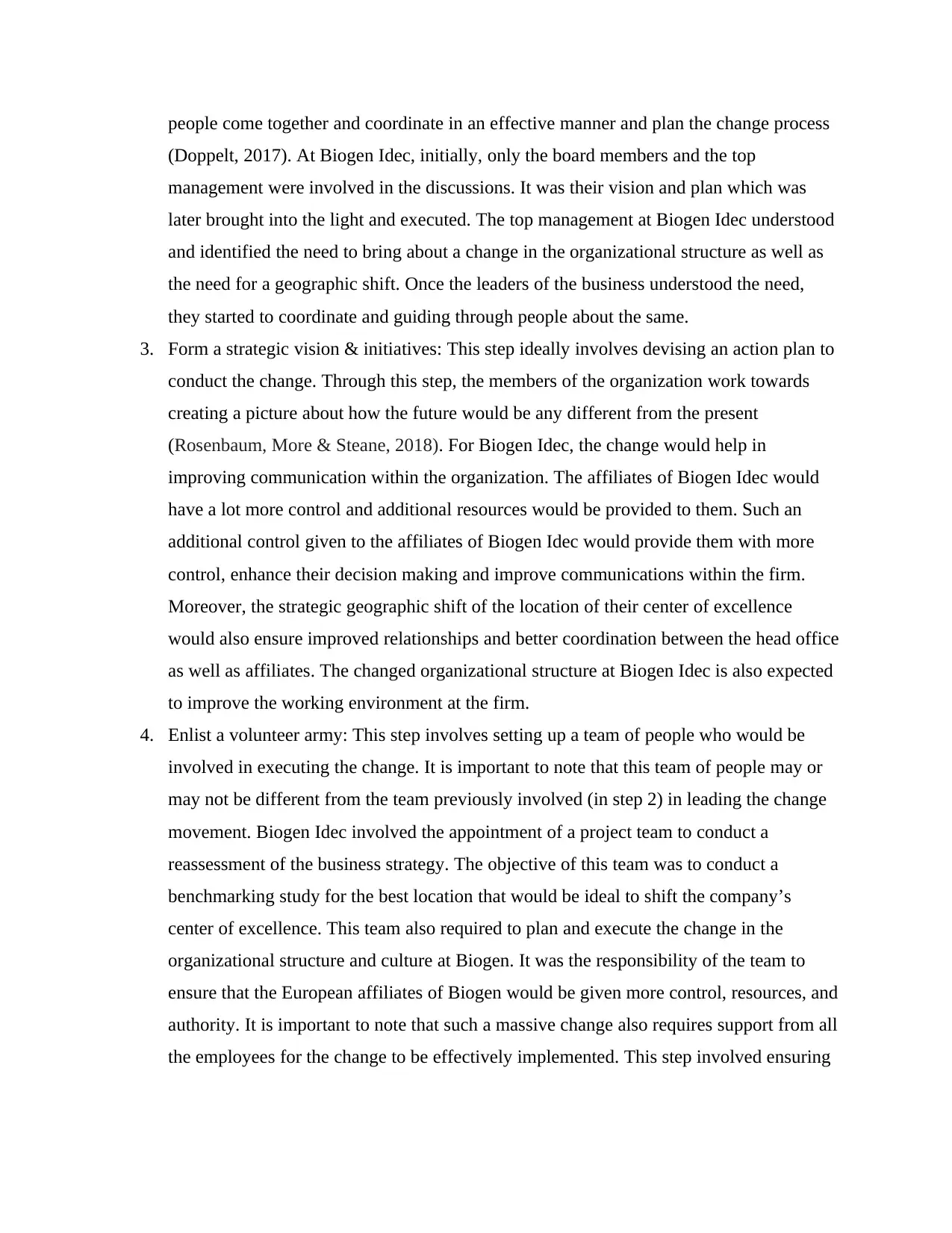
people come together and coordinate in an effective manner and plan the change process
(Doppelt, 2017). At Biogen Idec, initially, only the board members and the top
management were involved in the discussions. It was their vision and plan which was
later brought into the light and executed. The top management at Biogen Idec understood
and identified the need to bring about a change in the organizational structure as well as
the need for a geographic shift. Once the leaders of the business understood the need,
they started to coordinate and guiding through people about the same.
3. Form a strategic vision & initiatives: This step ideally involves devising an action plan to
conduct the change. Through this step, the members of the organization work towards
creating a picture about how the future would be any different from the present
(Rosenbaum, More & Steane, 2018). For Biogen Idec, the change would help in
improving communication within the organization. The affiliates of Biogen Idec would
have a lot more control and additional resources would be provided to them. Such an
additional control given to the affiliates of Biogen Idec would provide them with more
control, enhance their decision making and improve communications within the firm.
Moreover, the strategic geographic shift of the location of their center of excellence
would also ensure improved relationships and better coordination between the head office
as well as affiliates. The changed organizational structure at Biogen Idec is also expected
to improve the working environment at the firm.
4. Enlist a volunteer army: This step involves setting up a team of people who would be
involved in executing the change. It is important to note that this team of people may or
may not be different from the team previously involved (in step 2) in leading the change
movement. Biogen Idec involved the appointment of a project team to conduct a
reassessment of the business strategy. The objective of this team was to conduct a
benchmarking study for the best location that would be ideal to shift the company’s
center of excellence. This team also required to plan and execute the change in the
organizational structure and culture at Biogen. It was the responsibility of the team to
ensure that the European affiliates of Biogen would be given more control, resources, and
authority. It is important to note that such a massive change also requires support from all
the employees for the change to be effectively implemented. This step involved ensuring
(Doppelt, 2017). At Biogen Idec, initially, only the board members and the top
management were involved in the discussions. It was their vision and plan which was
later brought into the light and executed. The top management at Biogen Idec understood
and identified the need to bring about a change in the organizational structure as well as
the need for a geographic shift. Once the leaders of the business understood the need,
they started to coordinate and guiding through people about the same.
3. Form a strategic vision & initiatives: This step ideally involves devising an action plan to
conduct the change. Through this step, the members of the organization work towards
creating a picture about how the future would be any different from the present
(Rosenbaum, More & Steane, 2018). For Biogen Idec, the change would help in
improving communication within the organization. The affiliates of Biogen Idec would
have a lot more control and additional resources would be provided to them. Such an
additional control given to the affiliates of Biogen Idec would provide them with more
control, enhance their decision making and improve communications within the firm.
Moreover, the strategic geographic shift of the location of their center of excellence
would also ensure improved relationships and better coordination between the head office
as well as affiliates. The changed organizational structure at Biogen Idec is also expected
to improve the working environment at the firm.
4. Enlist a volunteer army: This step involves setting up a team of people who would be
involved in executing the change. It is important to note that this team of people may or
may not be different from the team previously involved (in step 2) in leading the change
movement. Biogen Idec involved the appointment of a project team to conduct a
reassessment of the business strategy. The objective of this team was to conduct a
benchmarking study for the best location that would be ideal to shift the company’s
center of excellence. This team also required to plan and execute the change in the
organizational structure and culture at Biogen. It was the responsibility of the team to
ensure that the European affiliates of Biogen would be given more control, resources, and
authority. It is important to note that such a massive change also requires support from all
the employees for the change to be effectively implemented. This step involved ensuring
⊘ This is a preview!⊘
Do you want full access?
Subscribe today to unlock all pages.

Trusted by 1+ million students worldwide
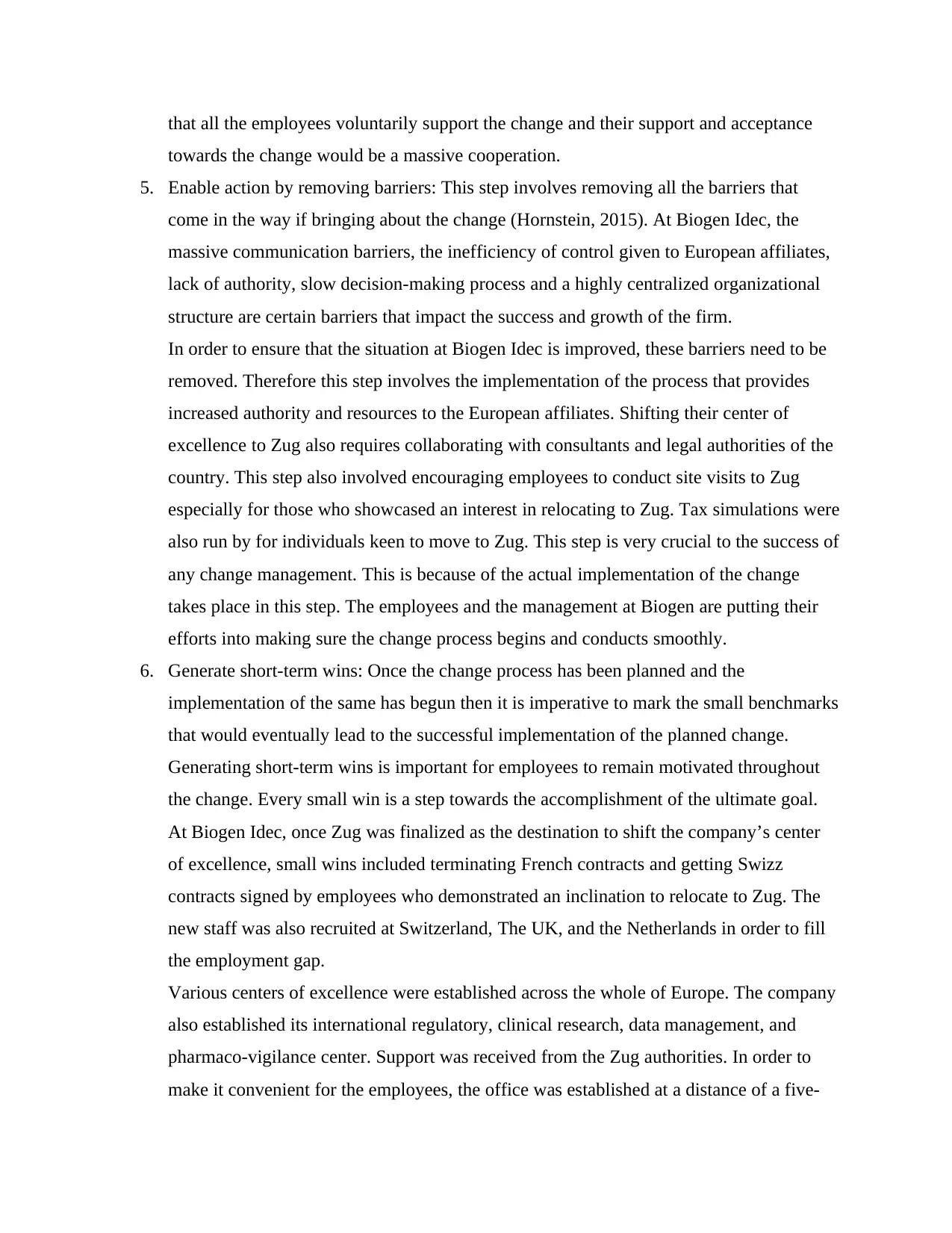
that all the employees voluntarily support the change and their support and acceptance
towards the change would be a massive cooperation.
5. Enable action by removing barriers: This step involves removing all the barriers that
come in the way if bringing about the change (Hornstein, 2015). At Biogen Idec, the
massive communication barriers, the inefficiency of control given to European affiliates,
lack of authority, slow decision-making process and a highly centralized organizational
structure are certain barriers that impact the success and growth of the firm.
In order to ensure that the situation at Biogen Idec is improved, these barriers need to be
removed. Therefore this step involves the implementation of the process that provides
increased authority and resources to the European affiliates. Shifting their center of
excellence to Zug also requires collaborating with consultants and legal authorities of the
country. This step also involved encouraging employees to conduct site visits to Zug
especially for those who showcased an interest in relocating to Zug. Tax simulations were
also run by for individuals keen to move to Zug. This step is very crucial to the success of
any change management. This is because of the actual implementation of the change
takes place in this step. The employees and the management at Biogen are putting their
efforts into making sure the change process begins and conducts smoothly.
6. Generate short-term wins: Once the change process has been planned and the
implementation of the same has begun then it is imperative to mark the small benchmarks
that would eventually lead to the successful implementation of the planned change.
Generating short-term wins is important for employees to remain motivated throughout
the change. Every small win is a step towards the accomplishment of the ultimate goal.
At Biogen Idec, once Zug was finalized as the destination to shift the company’s center
of excellence, small wins included terminating French contracts and getting Swizz
contracts signed by employees who demonstrated an inclination to relocate to Zug. The
new staff was also recruited at Switzerland, The UK, and the Netherlands in order to fill
the employment gap.
Various centers of excellence were established across the whole of Europe. The company
also established its international regulatory, clinical research, data management, and
pharmaco-vigilance center. Support was received from the Zug authorities. In order to
make it convenient for the employees, the office was established at a distance of a five-
towards the change would be a massive cooperation.
5. Enable action by removing barriers: This step involves removing all the barriers that
come in the way if bringing about the change (Hornstein, 2015). At Biogen Idec, the
massive communication barriers, the inefficiency of control given to European affiliates,
lack of authority, slow decision-making process and a highly centralized organizational
structure are certain barriers that impact the success and growth of the firm.
In order to ensure that the situation at Biogen Idec is improved, these barriers need to be
removed. Therefore this step involves the implementation of the process that provides
increased authority and resources to the European affiliates. Shifting their center of
excellence to Zug also requires collaborating with consultants and legal authorities of the
country. This step also involved encouraging employees to conduct site visits to Zug
especially for those who showcased an interest in relocating to Zug. Tax simulations were
also run by for individuals keen to move to Zug. This step is very crucial to the success of
any change management. This is because of the actual implementation of the change
takes place in this step. The employees and the management at Biogen are putting their
efforts into making sure the change process begins and conducts smoothly.
6. Generate short-term wins: Once the change process has been planned and the
implementation of the same has begun then it is imperative to mark the small benchmarks
that would eventually lead to the successful implementation of the planned change.
Generating short-term wins is important for employees to remain motivated throughout
the change. Every small win is a step towards the accomplishment of the ultimate goal.
At Biogen Idec, once Zug was finalized as the destination to shift the company’s center
of excellence, small wins included terminating French contracts and getting Swizz
contracts signed by employees who demonstrated an inclination to relocate to Zug. The
new staff was also recruited at Switzerland, The UK, and the Netherlands in order to fill
the employment gap.
Various centers of excellence were established across the whole of Europe. The company
also established its international regulatory, clinical research, data management, and
pharmaco-vigilance center. Support was received from the Zug authorities. In order to
make it convenient for the employees, the office was established at a distance of a five-
Paraphrase This Document
Need a fresh take? Get an instant paraphrase of this document with our AI Paraphraser
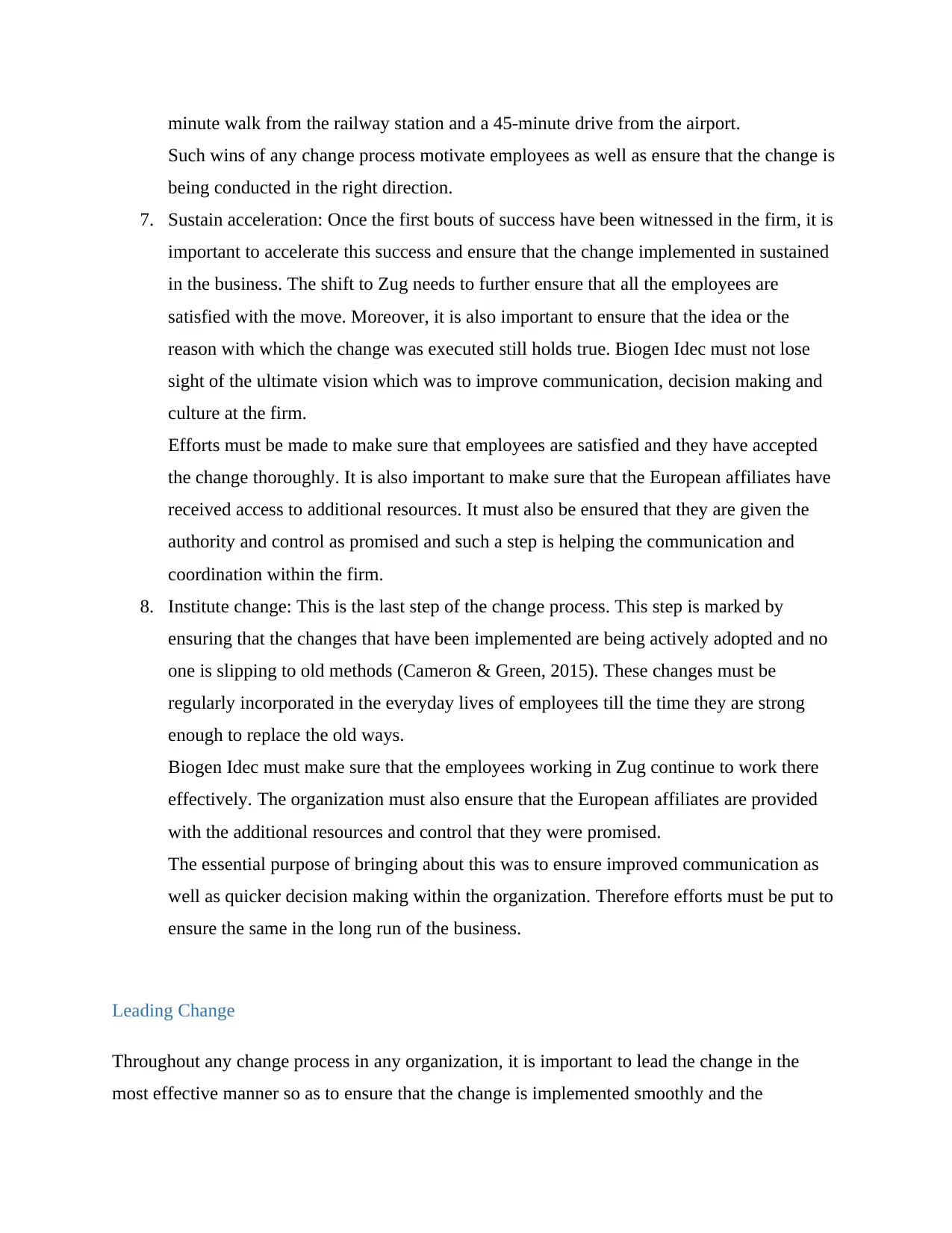
minute walk from the railway station and a 45-minute drive from the airport.
Such wins of any change process motivate employees as well as ensure that the change is
being conducted in the right direction.
7. Sustain acceleration: Once the first bouts of success have been witnessed in the firm, it is
important to accelerate this success and ensure that the change implemented in sustained
in the business. The shift to Zug needs to further ensure that all the employees are
satisfied with the move. Moreover, it is also important to ensure that the idea or the
reason with which the change was executed still holds true. Biogen Idec must not lose
sight of the ultimate vision which was to improve communication, decision making and
culture at the firm.
Efforts must be made to make sure that employees are satisfied and they have accepted
the change thoroughly. It is also important to make sure that the European affiliates have
received access to additional resources. It must also be ensured that they are given the
authority and control as promised and such a step is helping the communication and
coordination within the firm.
8. Institute change: This is the last step of the change process. This step is marked by
ensuring that the changes that have been implemented are being actively adopted and no
one is slipping to old methods (Cameron & Green, 2015). These changes must be
regularly incorporated in the everyday lives of employees till the time they are strong
enough to replace the old ways.
Biogen Idec must make sure that the employees working in Zug continue to work there
effectively. The organization must also ensure that the European affiliates are provided
with the additional resources and control that they were promised.
The essential purpose of bringing about this was to ensure improved communication as
well as quicker decision making within the organization. Therefore efforts must be put to
ensure the same in the long run of the business.
Leading Change
Throughout any change process in any organization, it is important to lead the change in the
most effective manner so as to ensure that the change is implemented smoothly and the
Such wins of any change process motivate employees as well as ensure that the change is
being conducted in the right direction.
7. Sustain acceleration: Once the first bouts of success have been witnessed in the firm, it is
important to accelerate this success and ensure that the change implemented in sustained
in the business. The shift to Zug needs to further ensure that all the employees are
satisfied with the move. Moreover, it is also important to ensure that the idea or the
reason with which the change was executed still holds true. Biogen Idec must not lose
sight of the ultimate vision which was to improve communication, decision making and
culture at the firm.
Efforts must be made to make sure that employees are satisfied and they have accepted
the change thoroughly. It is also important to make sure that the European affiliates have
received access to additional resources. It must also be ensured that they are given the
authority and control as promised and such a step is helping the communication and
coordination within the firm.
8. Institute change: This is the last step of the change process. This step is marked by
ensuring that the changes that have been implemented are being actively adopted and no
one is slipping to old methods (Cameron & Green, 2015). These changes must be
regularly incorporated in the everyday lives of employees till the time they are strong
enough to replace the old ways.
Biogen Idec must make sure that the employees working in Zug continue to work there
effectively. The organization must also ensure that the European affiliates are provided
with the additional resources and control that they were promised.
The essential purpose of bringing about this was to ensure improved communication as
well as quicker decision making within the organization. Therefore efforts must be put to
ensure the same in the long run of the business.
Leading Change
Throughout any change process in any organization, it is important to lead the change in the
most effective manner so as to ensure that the change is implemented smoothly and the
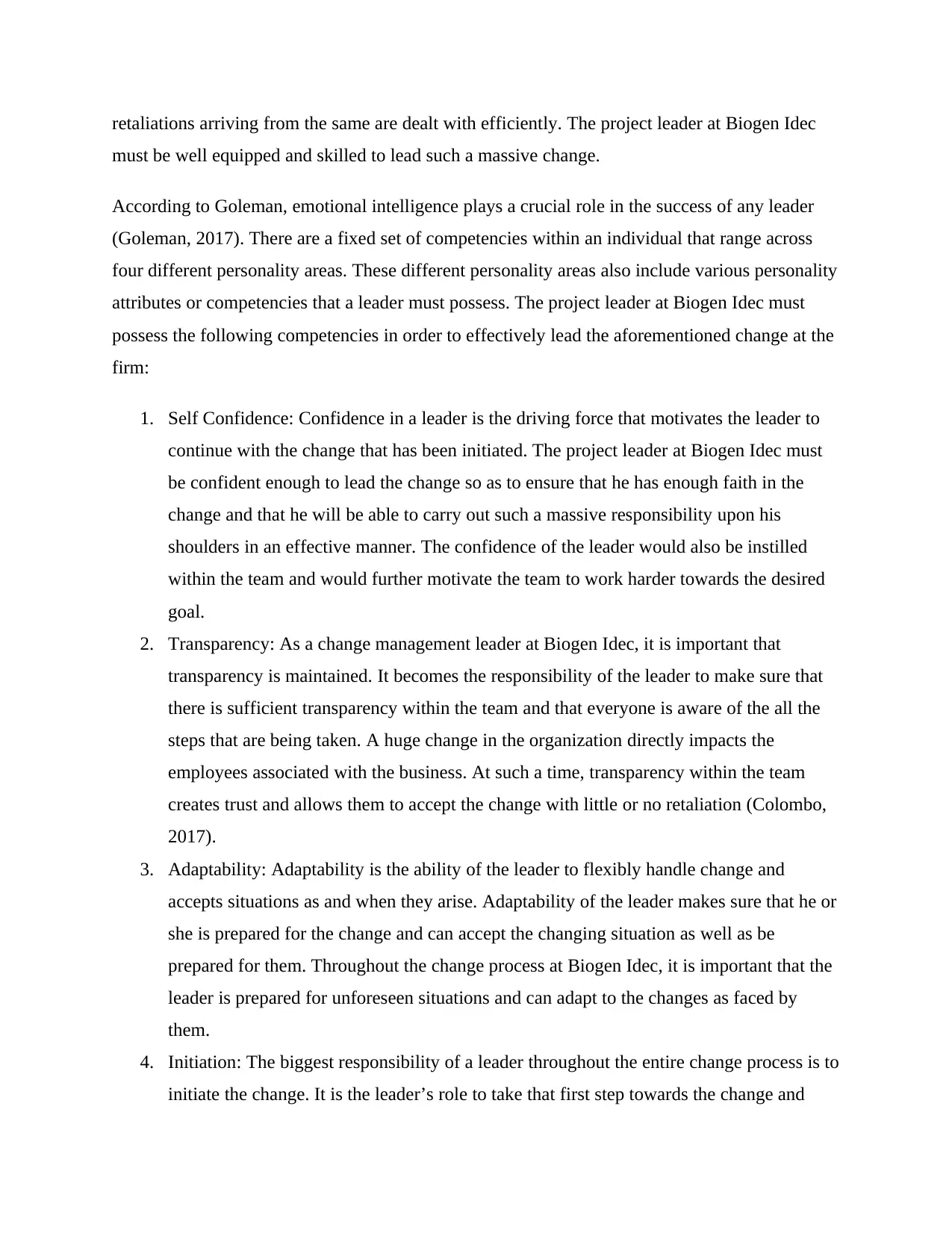
retaliations arriving from the same are dealt with efficiently. The project leader at Biogen Idec
must be well equipped and skilled to lead such a massive change.
According to Goleman, emotional intelligence plays a crucial role in the success of any leader
(Goleman, 2017). There are a fixed set of competencies within an individual that range across
four different personality areas. These different personality areas also include various personality
attributes or competencies that a leader must possess. The project leader at Biogen Idec must
possess the following competencies in order to effectively lead the aforementioned change at the
firm:
1. Self Confidence: Confidence in a leader is the driving force that motivates the leader to
continue with the change that has been initiated. The project leader at Biogen Idec must
be confident enough to lead the change so as to ensure that he has enough faith in the
change and that he will be able to carry out such a massive responsibility upon his
shoulders in an effective manner. The confidence of the leader would also be instilled
within the team and would further motivate the team to work harder towards the desired
goal.
2. Transparency: As a change management leader at Biogen Idec, it is important that
transparency is maintained. It becomes the responsibility of the leader to make sure that
there is sufficient transparency within the team and that everyone is aware of the all the
steps that are being taken. A huge change in the organization directly impacts the
employees associated with the business. At such a time, transparency within the team
creates trust and allows them to accept the change with little or no retaliation (Colombo,
2017).
3. Adaptability: Adaptability is the ability of the leader to flexibly handle change and
accepts situations as and when they arise. Adaptability of the leader makes sure that he or
she is prepared for the change and can accept the changing situation as well as be
prepared for them. Throughout the change process at Biogen Idec, it is important that the
leader is prepared for unforeseen situations and can adapt to the changes as faced by
them.
4. Initiation: The biggest responsibility of a leader throughout the entire change process is to
initiate the change. It is the leader’s role to take that first step towards the change and
must be well equipped and skilled to lead such a massive change.
According to Goleman, emotional intelligence plays a crucial role in the success of any leader
(Goleman, 2017). There are a fixed set of competencies within an individual that range across
four different personality areas. These different personality areas also include various personality
attributes or competencies that a leader must possess. The project leader at Biogen Idec must
possess the following competencies in order to effectively lead the aforementioned change at the
firm:
1. Self Confidence: Confidence in a leader is the driving force that motivates the leader to
continue with the change that has been initiated. The project leader at Biogen Idec must
be confident enough to lead the change so as to ensure that he has enough faith in the
change and that he will be able to carry out such a massive responsibility upon his
shoulders in an effective manner. The confidence of the leader would also be instilled
within the team and would further motivate the team to work harder towards the desired
goal.
2. Transparency: As a change management leader at Biogen Idec, it is important that
transparency is maintained. It becomes the responsibility of the leader to make sure that
there is sufficient transparency within the team and that everyone is aware of the all the
steps that are being taken. A huge change in the organization directly impacts the
employees associated with the business. At such a time, transparency within the team
creates trust and allows them to accept the change with little or no retaliation (Colombo,
2017).
3. Adaptability: Adaptability is the ability of the leader to flexibly handle change and
accepts situations as and when they arise. Adaptability of the leader makes sure that he or
she is prepared for the change and can accept the changing situation as well as be
prepared for them. Throughout the change process at Biogen Idec, it is important that the
leader is prepared for unforeseen situations and can adapt to the changes as faced by
them.
4. Initiation: The biggest responsibility of a leader throughout the entire change process is to
initiate the change. It is the leader’s role to take that first step towards the change and
⊘ This is a preview!⊘
Do you want full access?
Subscribe today to unlock all pages.

Trusted by 1+ million students worldwide
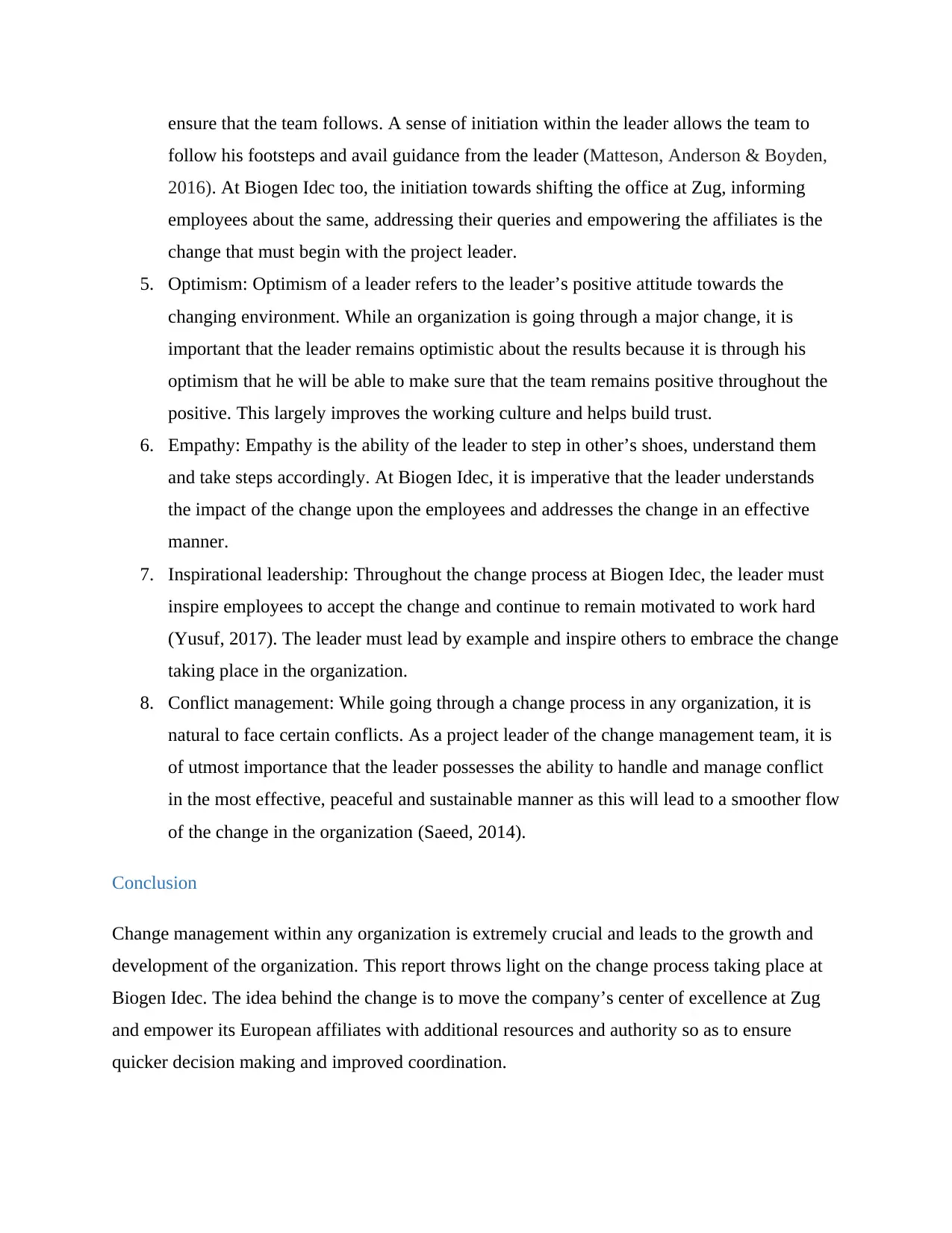
ensure that the team follows. A sense of initiation within the leader allows the team to
follow his footsteps and avail guidance from the leader (Matteson, Anderson & Boyden,
2016). At Biogen Idec too, the initiation towards shifting the office at Zug, informing
employees about the same, addressing their queries and empowering the affiliates is the
change that must begin with the project leader.
5. Optimism: Optimism of a leader refers to the leader’s positive attitude towards the
changing environment. While an organization is going through a major change, it is
important that the leader remains optimistic about the results because it is through his
optimism that he will be able to make sure that the team remains positive throughout the
positive. This largely improves the working culture and helps build trust.
6. Empathy: Empathy is the ability of the leader to step in other’s shoes, understand them
and take steps accordingly. At Biogen Idec, it is imperative that the leader understands
the impact of the change upon the employees and addresses the change in an effective
manner.
7. Inspirational leadership: Throughout the change process at Biogen Idec, the leader must
inspire employees to accept the change and continue to remain motivated to work hard
(Yusuf, 2017). The leader must lead by example and inspire others to embrace the change
taking place in the organization.
8. Conflict management: While going through a change process in any organization, it is
natural to face certain conflicts. As a project leader of the change management team, it is
of utmost importance that the leader possesses the ability to handle and manage conflict
in the most effective, peaceful and sustainable manner as this will lead to a smoother flow
of the change in the organization (Saeed, 2014).
Conclusion
Change management within any organization is extremely crucial and leads to the growth and
development of the organization. This report throws light on the change process taking place at
Biogen Idec. The idea behind the change is to move the company’s center of excellence at Zug
and empower its European affiliates with additional resources and authority so as to ensure
quicker decision making and improved coordination.
follow his footsteps and avail guidance from the leader (Matteson, Anderson & Boyden,
2016). At Biogen Idec too, the initiation towards shifting the office at Zug, informing
employees about the same, addressing their queries and empowering the affiliates is the
change that must begin with the project leader.
5. Optimism: Optimism of a leader refers to the leader’s positive attitude towards the
changing environment. While an organization is going through a major change, it is
important that the leader remains optimistic about the results because it is through his
optimism that he will be able to make sure that the team remains positive throughout the
positive. This largely improves the working culture and helps build trust.
6. Empathy: Empathy is the ability of the leader to step in other’s shoes, understand them
and take steps accordingly. At Biogen Idec, it is imperative that the leader understands
the impact of the change upon the employees and addresses the change in an effective
manner.
7. Inspirational leadership: Throughout the change process at Biogen Idec, the leader must
inspire employees to accept the change and continue to remain motivated to work hard
(Yusuf, 2017). The leader must lead by example and inspire others to embrace the change
taking place in the organization.
8. Conflict management: While going through a change process in any organization, it is
natural to face certain conflicts. As a project leader of the change management team, it is
of utmost importance that the leader possesses the ability to handle and manage conflict
in the most effective, peaceful and sustainable manner as this will lead to a smoother flow
of the change in the organization (Saeed, 2014).
Conclusion
Change management within any organization is extremely crucial and leads to the growth and
development of the organization. This report throws light on the change process taking place at
Biogen Idec. The idea behind the change is to move the company’s center of excellence at Zug
and empower its European affiliates with additional resources and authority so as to ensure
quicker decision making and improved coordination.
Paraphrase This Document
Need a fresh take? Get an instant paraphrase of this document with our AI Paraphraser
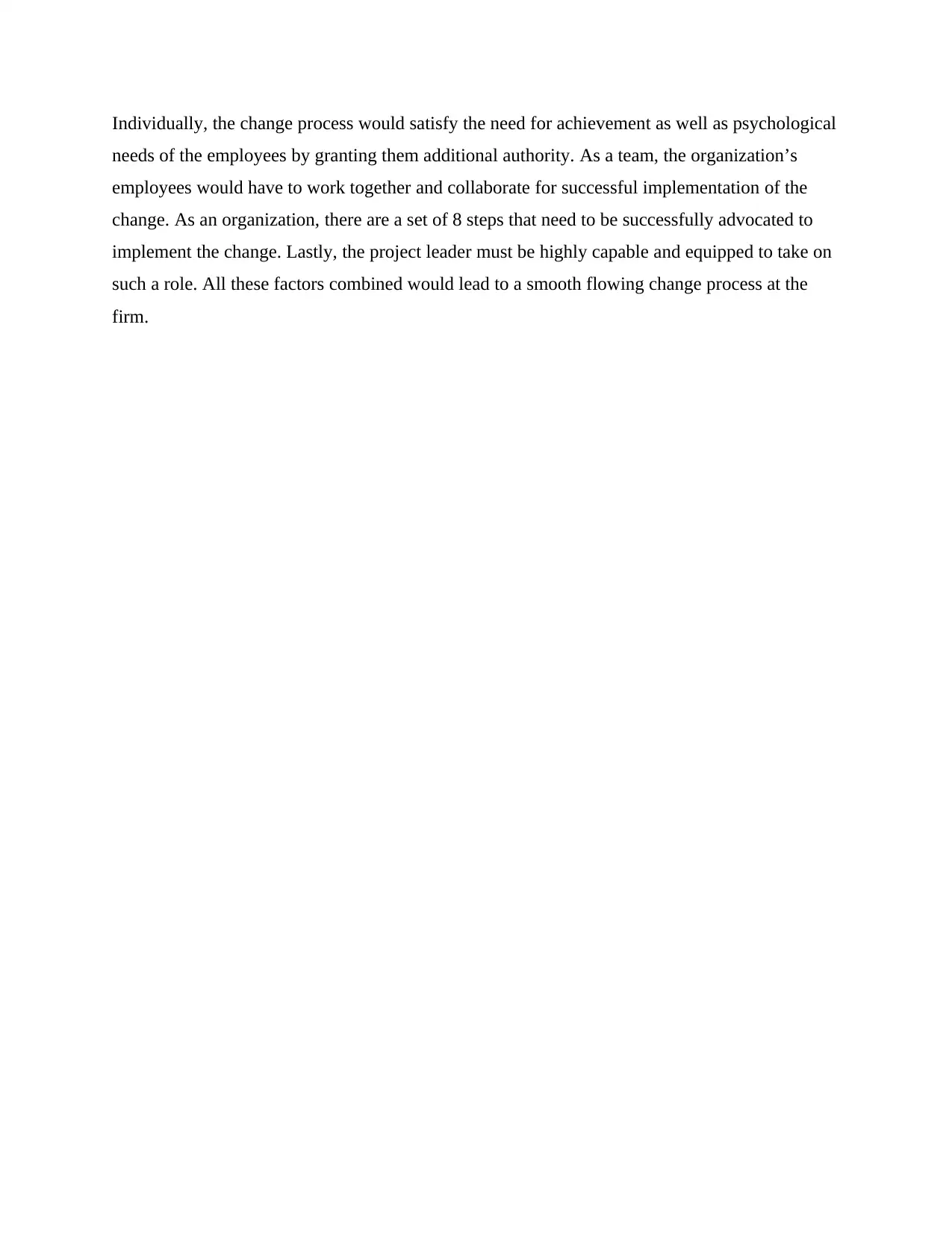
Individually, the change process would satisfy the need for achievement as well as psychological
needs of the employees by granting them additional authority. As a team, the organization’s
employees would have to work together and collaborate for successful implementation of the
change. As an organization, there are a set of 8 steps that need to be successfully advocated to
implement the change. Lastly, the project leader must be highly capable and equipped to take on
such a role. All these factors combined would lead to a smooth flowing change process at the
firm.
needs of the employees by granting them additional authority. As a team, the organization’s
employees would have to work together and collaborate for successful implementation of the
change. As an organization, there are a set of 8 steps that need to be successfully advocated to
implement the change. Lastly, the project leader must be highly capable and equipped to take on
such a role. All these factors combined would lead to a smooth flowing change process at the
firm.
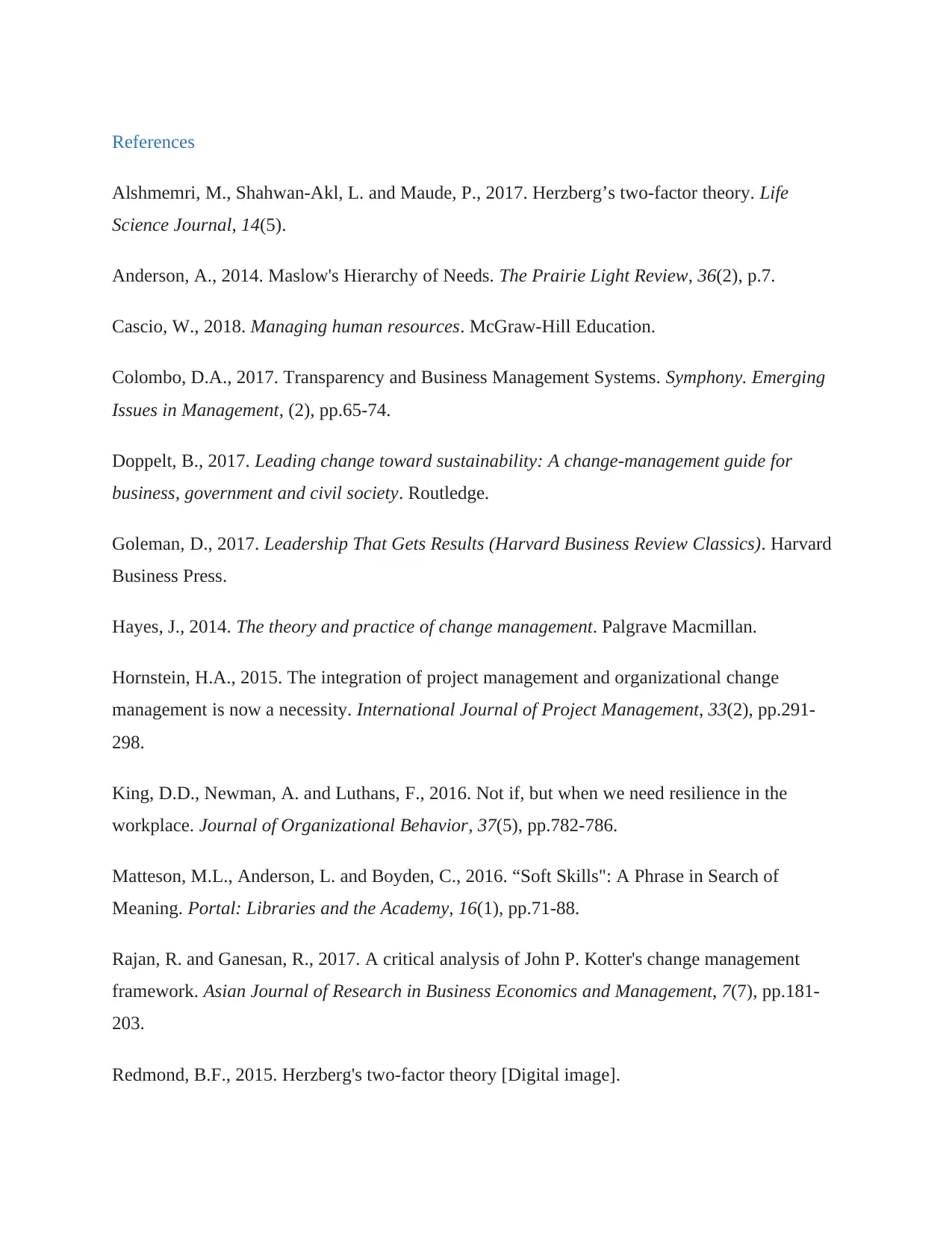
References
Alshmemri, M., Shahwan-Akl, L. and Maude, P., 2017. Herzberg’s two-factor theory. Life
Science Journal, 14(5).
Anderson, A., 2014. Maslow's Hierarchy of Needs. The Prairie Light Review, 36(2), p.7.
Cascio, W., 2018. Managing human resources. McGraw-Hill Education.
Colombo, D.A., 2017. Transparency and Business Management Systems. Symphony. Emerging
Issues in Management, (2), pp.65-74.
Doppelt, B., 2017. Leading change toward sustainability: A change-management guide for
business, government and civil society. Routledge.
Goleman, D., 2017. Leadership That Gets Results (Harvard Business Review Classics). Harvard
Business Press.
Hayes, J., 2014. The theory and practice of change management. Palgrave Macmillan.
Hornstein, H.A., 2015. The integration of project management and organizational change
management is now a necessity. International Journal of Project Management, 33(2), pp.291-
298.
King, D.D., Newman, A. and Luthans, F., 2016. Not if, but when we need resilience in the
workplace. Journal of Organizational Behavior, 37(5), pp.782-786.
Matteson, M.L., Anderson, L. and Boyden, C., 2016. “Soft Skills": A Phrase in Search of
Meaning. Portal: Libraries and the Academy, 16(1), pp.71-88.
Rajan, R. and Ganesan, R., 2017. A critical analysis of John P. Kotter's change management
framework. Asian Journal of Research in Business Economics and Management, 7(7), pp.181-
203.
Redmond, B.F., 2015. Herzberg's two-factor theory [Digital image].
Alshmemri, M., Shahwan-Akl, L. and Maude, P., 2017. Herzberg’s two-factor theory. Life
Science Journal, 14(5).
Anderson, A., 2014. Maslow's Hierarchy of Needs. The Prairie Light Review, 36(2), p.7.
Cascio, W., 2018. Managing human resources. McGraw-Hill Education.
Colombo, D.A., 2017. Transparency and Business Management Systems. Symphony. Emerging
Issues in Management, (2), pp.65-74.
Doppelt, B., 2017. Leading change toward sustainability: A change-management guide for
business, government and civil society. Routledge.
Goleman, D., 2017. Leadership That Gets Results (Harvard Business Review Classics). Harvard
Business Press.
Hayes, J., 2014. The theory and practice of change management. Palgrave Macmillan.
Hornstein, H.A., 2015. The integration of project management and organizational change
management is now a necessity. International Journal of Project Management, 33(2), pp.291-
298.
King, D.D., Newman, A. and Luthans, F., 2016. Not if, but when we need resilience in the
workplace. Journal of Organizational Behavior, 37(5), pp.782-786.
Matteson, M.L., Anderson, L. and Boyden, C., 2016. “Soft Skills": A Phrase in Search of
Meaning. Portal: Libraries and the Academy, 16(1), pp.71-88.
Rajan, R. and Ganesan, R., 2017. A critical analysis of John P. Kotter's change management
framework. Asian Journal of Research in Business Economics and Management, 7(7), pp.181-
203.
Redmond, B.F., 2015. Herzberg's two-factor theory [Digital image].
⊘ This is a preview!⊘
Do you want full access?
Subscribe today to unlock all pages.

Trusted by 1+ million students worldwide
1 out of 13
Related Documents
Your All-in-One AI-Powered Toolkit for Academic Success.
+13062052269
info@desklib.com
Available 24*7 on WhatsApp / Email
![[object Object]](/_next/static/media/star-bottom.7253800d.svg)
Unlock your academic potential
Copyright © 2020–2025 A2Z Services. All Rights Reserved. Developed and managed by ZUCOL.





